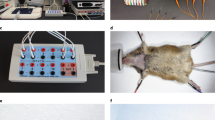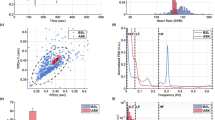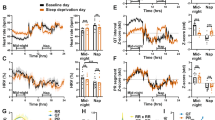Abstract
The normal heartbeat slightly fluctuates around a mean value; this phenomenon is called physiological heart rate variability (HRV). It is well known that altered HRV is a risk factor for sudden cardiac death. The availability of genetic mouse models makes it possible to experimentally dissect the mechanism of pathological changes in HRV and its relation to sudden cardiac death. Here we provide a protocol that allows for a comprehensive multilevel analysis of heart rate (HR) fluctuations. The protocol comprises a set of techniques that include in vivo telemetry and in vitro electrophysiology of intact sinoatrial network preparations or isolated single sinoatrial node (SAN) cells. In vitro preparations can be completed within a few hours, with data acquisition within 1 d. In vivo telemetric ECG requires 1 h for surgery and several weeks for data acquisition and analysis. This protocol is of interest to researchers investigating cardiovascular physiology and the pathophysiology of sudden cardiac death.
This is a preview of subscription content, access via your institution
Access options
Subscribe to this journal
Receive 12 print issues and online access
$259.00 per year
only $21.58 per issue
Buy this article
- Purchase on Springer Link
- Instant access to full article PDF
Prices may be subject to local taxes which are calculated during checkout

















Similar content being viewed by others
References
Mangoni, M.E. & Nargeot, J. Genesis and regulation of the heart automaticity. Physiol. Rev. 88, 919–982 (2008).
Campos, L.A. et al. Mathematical biomarkers for the autonomic regulation of cardiovascular system. Front. Physiol. 4, 279 (2013).
Metelka, R. Heart rate variability—current diagnosis of the cardiac autonomic neuropathy. A review. Biomed. Pap. Med. Fac. Univ. Palacky Olomouc Czech Repub. 158, 327–338 (2014).
Stein, P.K. & Kleiger, R.E. Insights from the study of heart rate variability. Annu. Rev. Med. 50, 249–261 (1999).
Bernardi, L. et al. Respiratory sinus arrhythmia in the denervated human heart. J. Appl. Physiol. (1985) 67, 1447–1455 (1989).
Stauss, H.M. Heart rate variability. Am. J. Physiol. Regul. Integr. Comp. Physiol. 285, R927–R931 (2003).
Akselrod, S. et al. Hemodynamic regulation: investigation by spectral analysis. Am. J. Physiol. 249, H867–H875 (1985).
Bergfeldt, L. & Haga, Y. Power spectral and Poincaré plot characteristics in sinus node dysfunction. J. Appl. Physiol. (1985) 94, 2217–2224 (2003).
Zaza, A. & Lombardi, F. Autonomic indexes based on the analysis of heart rate variability: a view from the sinus node. Cardiovasc. Res. 50, 434–442 (2001).
Freeman, R. Assessment of cardiovascular autonomic function. Clin. Neurophysiol. 117, 716–730 (2006).
Papaioannou, V.E., Verkerk, A.O., Amin, A.S. & de Bakker, J.M. Intracardiac origin of heart rate variability, pacemaker funny current and their possible association with critical illness. Curr. Cardiol. Rev. 9, 82–96 (2013).
Piccirillo, G. et al. Power spectral analysis of heart rate variability and autonomic nervous system activity measured directly in healthy dogs and dogs with tachycardia-induced heart failure. Heart Rhythm 6, 546–552 (2009).
Stein, P.K., Domitrovich, P.P., Hui, N., Rautaharju, P. & Gottdiener, J. Sometimes higher heart rate variability is not better heart rate variability: results of graphical and nonlinear analyses. J. Cardiovasc. Electrophysiol. 16, 954–959 (2005).
de Bruyne, M.C. et al. Both decreased and increased heart rate variability on the standard 10-second electrocardiogram predict cardiac mortality in the elderly: the Rotterdam Study. Am. J. Epidemiol. 150, 1282–1288 (1999).
Fenske, S. et al. Sick sinus syndrome in HCN1-deficient mice. Circulation 128, 2585–2594 (2013).
Wahl-Schott, C., Fenske, S. & Biel, M. HCN channels: new roles in sinoatrial node function. Curr. Opin. Pharmacol. 15, 83–90 (2014).
Lombardi, F. & Stein, P.K. Origin of heart rate variability and turbulence: an appraisal of autonomic modulation of cardiovascular function. Front. Physiol. 2, 95 (2011).
Monfredi, O. et al. Biophysical characterization of the underappreciated and important relationship between heart rate variability and heart rate. Hypertension 64, 1334–1343 (2014).
Berger, R.D, Saul, J.P. & Cohen, R.J. Transfer function analysis of autonomic regulation. I. Canine atrial rate response. Am. J. Physiol. 256, H142–H152 (1989).
Zuberi, Z., Birnbaumer, L. & Tinker, A. The role of inhibitory heterotrimeric G proteins in the control of in vivo heart rate dynamics. Am. J. Physiol. Regul. Integr. Comp. Physiol. 295, R1822–R1830 (2008).
Sebastian, S. et al. The in vivo regulation of heart rate in the murine sinoatrial node by stimulatory and inhibitory heterotrimeric G proteins. Am. J. Physiol. Regul. Integr. Comp. Physiol. 305, R435–R442 (2013).
Berntson, G.G. et al. Heart rate variability: origins, methods, and interpretive caveats. Psychophysiology 34, 623–648 (1997).
Billman, G.E. The LF/HF ratio does not accurately measure cardiac sympatho-vagal balance. Front. Physiol. 4, 26 (2013).
Task Force of the European Society of Cardiology and the North American Society of Pacing and Electrophysiology. Heart rate variability: standards of measurement, physiological interpretation and clinical use. Circulation 93, 1043–1065 (1996).
Akselrod, S. et al. Power spectrum analysis of heart rate fluctuation: a quantitative probe of beat-to-beat cardiovascular control. Science 213, 220–222 (1981).
Hyndman, B.W., Kitney, R.I. & Sayers, B.M. Spontaneous rhythms in physiological control systems. Nature 233, 339–341 (1971).
Thireau, J., Zhang, B.L., Poisson, D. & Babuty, D. Heart rate variability in mice: a theoretical and practical guide. Exp. Physiol. 93, 83–94 (2008).
Ishii, K., Kuwahara, M., Tsubone, H. & Sugano, S. Autonomic nervous function in mice and voles (Microtus arvalis): investigation by power spectral analysis of heart rate variability. Lab. Anim. 30, 359–364 (1996).
Joaquim, L.F. et al. Enhanced heart rate variability and baroreflex index after stress and cholinesterase inhibition in mice. Am. J. Physiol. Heart Circ. Physiol. 287, H251–H257 (2004).
Baudrie, V., Laude, D. & Elghozi, J.L. Optimal frequency ranges for extracting information on cardiovascular autonomic control from the blood pressure and pulse interval spectrograms in mice. Am. J. Physiol. Regul. Integr. Comp. Physiol. 292, R904–R912 (2007).
Swaminathan, P.D. et al. Oxidized CaMKII causes cardiac sinus node dysfunction in mice. J. Clin. Invest. 121, 3277–3288 (2011).
Baldesberger, S. et al. Sinus node disease and arrhythmias in the long-term follow-up of former professional cyclists. Eur. Heart J. 29, 71–78 (2008).
Nikolic, G., Bishop, R.L. & Singh, J.B. Sudden death recorded during Holter monitoring. Circulation 66, 218–225 (1982).
Kleiger, R.E., Miller, J.P., Bigger, J.T. Jr. & Moss, A.J. Decreased heart rate variability and its association with increased mortality after acute myocardial infarction. Am. J. Cardiol. 59, 256–262 (1987).
Billman, G.E. Heart rate variability—a historical perspective. Front. Physiol. 2, 86 (2011).
Dekker, J.M. et al. Low heart rate variability in a 2-minute rhythm strip predicts risk of coronary heart disease and mortality from several causes: the ARIC Study. Atherosclerosis Risk In Communities. Circulation 102, 1239–1244 (2000).
Dekker, J.M. et al. Heart rate variability from short electrocardiographic recordings predicts mortality from all causes in middle-aged and elderly men. The Zutphen Study. Am. J. Epidemiol. 145, 899–908 (1997).
Galinier, M. et al. Depressed low frequency power of heart rate variability as an independent predictor of sudden death in chronic heart failure. Eur. Heart J. 21, 475–482 (2000).
Huikuri, H.V. & Stein, P.K. Heart rate variability in risk stratification of cardiac patients. Prog. Cardiovasc. Dis. 56, 153–159 (2013).
Herrmann, S., Fabritz, L., Layh, B., Kirchhof, P. & Ludwig, A. Insights into sick sinus syndrome from an inducible mouse model. Cardiovasc. Res. 90, 38–48 (2011).
Hoesl, E. et al. Tamoxifen-inducible gene deletion in the cardiac conduction system. J. Mol. Cell. Cardiol. 45, 62–69 (2008).
Qian, L., Berry, E.C., Fu, J.D., Ieda, M. & Srivastava, D. Reprogramming of mouse fibroblasts into cardiomyocyte-like cells in vitro. Nat. Protoc. 8, 1204–1215 (2013).
Direnberger, S. et al. Biocompatibility of a genetically encoded calcium indicator in a transgenic mouse model. Nat. Commun. 3, 1031 (2012).
Boukens, B.J., Rivaud, M.R., Rentschler, S. & Coronel, R. Misinterpretation of the mouse ECG: 'musing the waves of Mus musculus'. J. Physiol. 592, 4613–4626 (2014).
Wehrens, X.H., Kirchhoff, S. & Doevendans, P.A. Mouse electrocardiography: an interval of thirty years. Cardiovasc. Res. 45, 231–237 (2000).
Pauza, D.H. et al. Neuroanatomy of the murine cardiac conduction system: a combined stereomicroscopic and fluorescence immunohistochemical study. Auton. Neurosci. 176, 32–47 (2013).
Tarvainen, M.P., Ranta-aho, P.O. & Karjalainen, P.A. An advanced detrending method with application to HRV analysis. IEEE Trans. Biomed. Eng. 49, 172–175 (2002).
Senador, D., Kanakamedala, K., Irigoyen, M.C., Morris, M. & Elased, K.M. Cardiovascular and autonomic phenotype of db/db diabetic mice. Exp. Physiol. 94, 648–658 (2009).
Kralemann, B. et al. In vivo cardiac phase-response curve elucidates human respiratory heart rate variability. Nat. Commun. 4, 2418 (2013).
Ecker, P.M. et al. Effect of targeted deletions of β1- and β2-adrenergic-receptor subtypes on heart rate variability. Am. J. Physiol. Heart Circ. Physiol. 290, H192–H199 (2006).
Acknowledgements
We thank K. Hennis for technical assistance with the Langendorff perfusion. The work of D.H.P. was supported by the Research Council of Lithuania (grant no. MIP-13037). This work was supported, in part, by funding from the German Research Foundation (DFG grant nos. BI 484/5-1, WA 2597/3-1 and SFB TRR 152 TP12) to M.B. and C.W.-S..
Author information
Authors and Affiliations
Contributions
S.F. carried out the experiments and data analysis that formed the basis of the protocol, wrote the manuscript and composed all figures. R.P. provided images of isolated SAN cells, as well as images and videos of the anatomic localization of the SAN and isolation of the SAN, and wrote the manuscript. F.A. wrote the MATLAB script and performed data analysis. S.H. performed data analysis. V.M. and M.B. wrote the manuscript. D.H.P. developed the technique for inflation of the heart with gelatin and provided images of the anatomic localization of the SAN. C.W.-S. wrote the manuscript and designed the protocol.
Ethics declarations
Competing interests
The authors declare no competing financial interests.
Integrated supplementary information
Supplementary Figure 1 Step-by-step exposure and dissection of the SAN.
(a) Posterior view of the isolated heart with tissue that must be removed for SAN dissection. (b) Lungs, esophagus, large parts of the thymus and fat are removed to expose the central SAN region. At this stage it is already possible to dissect the SAN. Black arrow heads: vagus nerve, white arrow heads: sulcus terminalis. (c) Same heart after complete removal of excess tissue. The white dotted line indicates the cutting line for SAN dissection. The white dot indicates the area where the SAN should be gently hold with fine forceps for isolation. Other parts should not be touched to avoid damage of the central SAN region. Please note that removal of all surrounding tissue was done for demonstration purposes only and is not necessary for SAN dissection. (d) The SAN was dissected and is placed on the ventricles for demonstration. The white dot indicates the area where the SAN was grabbed with fine forceps. Th: thymus, Lu: parts of the lung, Es: esophagus, RAA: right atrial appendage, LV: left ventricle, RV: right ventricle, SAN: sinoatrial node, ST: sulcus terminalis, SVC: right superior vena cava, IVC: inferior vena cava, VN: vagus nerve, Ao: Aorta. Scale bar: 1 mm.
Supplementary Figure 2 Dissection of a whole mount SAN preparation of a gelatin-inflated heart.
(a) Dorsal view of the heart. All excess tissue and organs were removed. The white dotted line indicates the first cutting line along the sulcus coronarius. The second cut (yellow dotted line) is made after folding up the RAA and cutting along the sulcus coronarius up to the superior caval vein. The third cut (black dotted line) is made slightly left of the IVC along the intraatrial septum up to the SVC. The whole mount preparation is isolated completely by making a connecting cut (red dotted line) between the root of the aorta and the root of the right superior caval vein. SVC: right superior vena cava, IVC: inferior vena cava, PV: pulmonary veins, RAA: right atrial appendage, LV: left ventricle, RV: right ventricle, Ao: Aorta (b) The first incision is indicated by white arrow heads. The second and third incision cannot be seen because they lie behind the RAA and IVC, respectively. (c) The last connecting cut leads to complete isolation of the whole mount SAN preparation. (d) Heart together with whole mount SAN preparation. Scale bar: 1 mm.
Supplementary Figure 3 Ventral view of the gelatin- inflated heart.
Black dotted line indicates optimal length of Aorta for cannulation. Ao: Aorta; LCA: left carotid artery; RCA: right carotid artery; PT: pulmonary truncus; RSA: right subclavian artery; LAA: left atrial appendage; RAA: right atrial appendage, LV: left ventricle: RV: right ventricle. Scale bar: 1 mm
Supplementary information
Supplementary Text and Figures
Supplementary Figures 1–3, Supplementary Tables 1 and 2, Supplementary Methods 1–3 (PDF 1584 kb)
Supplementary Data 1
Zip file containing 4 MATLAB scripts. (ZIP 6 kb)
Supplementary Data 2
Raw data files for the tachograms shown in Figure 15g, Figure 16f and Figure 17f. These data files were used for the data analysis shown in Figure 15h-l, Figure 16g-k and Figure 17g-k. (XLSX 21 kb)
Anatomy and localization of the SAN 1.
Panoramic view across the supraventricular part of a gelatine inflated heart from the inferior vena cava over the SAN area to the right atrium. (MP4 1994 kb)
Anatomy and localization of the SAN 2.
View of an untreated heart before removal of the surrounding tissue. Fine forceps show the location of the SAN area. (MP4 2543 kb)
Rights and permissions
About this article
Cite this article
Fenske, S., Pröbstle, R., Auer, F. et al. Comprehensive multilevel in vivo and in vitro analysis of heart rate fluctuations in mice by ECG telemetry and electrophysiology. Nat Protoc 11, 61–86 (2016). https://doi.org/10.1038/nprot.2015.139
Published:
Issue Date:
DOI: https://doi.org/10.1038/nprot.2015.139
This article is cited by
-
What to consider for ECG in mice—with special emphasis on telemetry
Mammalian Genome (2023)
-
In vivo and ex vivo electrophysiological study of the mouse heart to characterize the cardiac conduction system, including atrial and ventricular vulnerability
Nature Protocols (2022)
-
Cellular and molecular landscape of mammalian sinoatrial node revealed by single-cell RNA sequencing
Nature Communications (2021)
-
Moving average and standard deviation thresholding (MAST): a novel algorithm for accurate R-wave detection in the murine electrocardiogram
Journal of Comparative Physiology B (2021)
-
cAMP-dependent regulation of HCN4 controls the tonic entrainment process in sinoatrial node pacemaker cells
Nature Communications (2020)
Comments
By submitting a comment you agree to abide by our Terms and Community Guidelines. If you find something abusive or that does not comply with our terms or guidelines please flag it as inappropriate.



